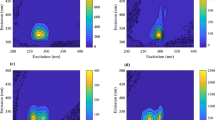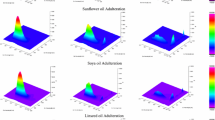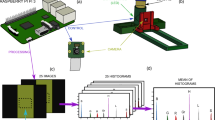Abstract
Walnut oil (WNO) is considered as natural functional food of high economic interest due to its nutritional and medicinal benefits. Adulteration in WNO seriously damages the interests of consumers and the health of market. In this paper, a new strategy has been developed to identify the adulteration of WNO with other cheaper vegetable oils. The study was based on the chemometric analysis of excitation-emission matrix (EEM) fluorescence spectroscopy data of WNO samples containing different adulterants. First, alternating normalization-weighted error (ANWE) method was used for the data decomposition of oil samples to obtain spectral characteristics and chemical meaning information. Then, three pattern recognition methods were employed to build the classification models, including partial least squares discriminant analysis employing ANWE scores (ANWE-PLS-DA), k-nearest neighbor (kNN), and N-way partial least squares discriminant analysis (N-PLS-DA). Results showed that all models obtained good classification performances for the WNO and other vegetable oils (case 1). Moreover, N-PLS-DA outperformed ANWE-PLS-DA and kNN in the identification of pure and adulterated WNO samples (case 2). The accuracy rates of N-PLS-DA were 87.1–90.6% when predicting WNO samples with adulteration level above 5%. The proposed methods were simple, rapid, and available for the identification of cheaper vegetable oil adulterated in WNO.





Similar content being viewed by others
References
J.A. Pereira, I. Oliveira, A. Sousa, I.C. Ferreira, A. Bento, L. Estevinho, Bioactive properties and chemical composition of six walnut (Juglans regia L.) cultivars. Food Chem. Toxicol. 46(6), 2103–2111 (2008). https://doi.org/10.1016/j.fct.2008.02.002
C. Crews, P. Hough, J. Godward, P. Brereton, M. Lees, S. Guiet, W. Winkelmann, Study of the main constituents of some authentic hazelnut oils. J. Agric. Food. Chem. 53(12), 4843–4852 (2005). https://doi.org/10.1021/jf0478354
S.M.T. Gharibzahedi, S.M. Mousavi, M. Hamedi, F. Khodaiyan, Determination and characterization of kernel biochemical composition and functional compounds of Persian walnut oil. J. Food Sci. Technol. 51, 34–42 (2014). https://doi.org/10.1007/s13197-011-0481-2
C. Alasalvar, J.-S. Salvadó, E. Ros, Bioactives and health benefits of nuts and dried fruits. Food Chem. 314, 126192 (2020). https://doi.org/10.1016/j.foodchem.2020.126192
M. De Lorgeril, P. Salen, Alpha-linolenic acid and coronary heart disease. Nutr. Metab. Cardiovasc. Dis. 14(3), 162–169 (2004). https://doi.org/10.1016/S0939-4753(04)80037-1
F. Lavedrine, D. Zmirou, A. Ravel, F. Balducci, J. Alary, Blood cholesterol and walnut consumption: a cross-sectional survey in France. Prev. Med. 28(4), 333–339 (1999). https://doi.org/10.1006/pmed.1999.0460
D. Hayes, M.J. Angove, J. Tucci, C. Dennis, Walnuts (Juglans regia) chemical composition and research in human health. Crit. Rev. Food Sci. Nutr. 56(8), 1231–1241 (2016). https://doi.org/10.1080/10408398.2012.760516
C. **ng, X. Yuan, X. Wu, X. Shao, J. Yuan, W. Yan, Chemometric classification and quantification of sesame oil adulterated with other vegetable oils based on fatty acids composition by gas chromatography. LWT 108, 437–445 (2019). https://doi.org/10.1016/j.lwt.2019.03.085
A. Rueda, C. Samaniego-Sánchez, M. Olalla, R. Giménez, C. Cabrera-Vique, I. Seiquer, L. Lara, Combination of analytical and chemometric methods as a useful tool for the characterization of extra virgin argan oil and other edible virgin oils. Role of polyphenols and tocopherols. J. AOAC Int. 99(2), 489–494 (2016). https://doi.org/10.5740/jaoacint.15-0121
N.P. Kalogiouri, N. Manousi, E. Rosenberg, G.A. Zachariadis, A. Paraskevopoulou, V. Samanidou, Exploring the volatile metabolome of conventional and organic walnut oils by solid-phase microextraction and analysis by GC-MS combined with chemometrics. Food Chem. 363, 130331 (2021). https://doi.org/10.1016/j.foodchem.2021.130331
A. Jakab, K. Héberger, E. Forgács, Comparative analysis of different plant oils by high-performance liquid chromatography–atmospheric pressure chemical ionization mass spectrometry. J. Chromatogr. A 976, 255–263 (2002). https://doi.org/10.1016/s0021-9673(02)01233-5
H. Karami, M. Rasekh, E. Mirzaee-Ghaleh, Qualitative analysis of edible oil oxidation using an olfactory machine. J. Food Meas. Charact. 14(5), 2600–2610 (2020). https://doi.org/10.1007/s11694-020-00506-0
C.A. Nunes, Vibrational spectroscopy and chemometrics to assess authenticity, adulteration and intrinsic quality parameters of edible oils and fats. Food Res. Int. 60, 255–261 (2014). https://doi.org/10.1016/j.foodres.2013.08.041
R. Jamwal, S. Kumari, S. Sharma, S. Kelly, A. Cannavan, D.K. Singh, Recent trends in the use of FTIR spectroscopy integrated with chemometrics for the detection of edible oil adulteration. Vib. Spectrosc. 113, 103222 (2021). https://doi.org/10.1016/j.vibspec.2021.103222
B. Li, H. Wang, Q. Zhao, J. Ouyang, Y. Wu, Rapid detection of authenticity and adulteration of walnut oil by FTIR and fluorescence spectroscopy: a comparative study. Food Chem. 181, 25–30 (2015). https://doi.org/10.1016/j.foodchem.2015.02.079
H.T. Temiz, S.D. Velioglu, K.G. Guner, H.M. Velioglu, The use of Raman spectroscopy and chemometrics for the discrimination of lab-produced, commercial, and adulterated cold-pressed oils. LWT 146, 111479 (2021). https://doi.org/10.1016/j.lwt.2021.111479
G.Y. Tiryaki, H. Ayvaz, Quantification of soybean oil adulteration in extra virgin olive oil using portable raman spectroscopy. J. Food Meas. Charact. 11(2), 523–529 (2017). https://doi.org/10.1007/s11694-016-9419-8
F. Turrini, P. Zunin, R. Boggia, Potentialities of rapid analytical strategies for the identification of the botanical species of several “Specialty” or “Gourmet” oils. Foods 10, 183 (2021). https://doi.org/10.3390/foods10010183
R. Popescu, R.E. Ionete, O.R. Botoran, D. Costinel, F. Bucura, E.I. Geana, Y.F.J. Alabedallat, M. Botu, 1H-NMR profiling and carbon isotope discrimination as tools for the comparative assessment of walnut (Juglans regia L.) cultivars with various geographical and genetic origins—a preliminary study. Molecules 24, 1378 (2019). https://doi.org/10.3390/molecules24071378
A. Dankowska, Advances in fluorescence emission spectroscopy for food authenticity testing, Advances in Food Authenticity Testing (Elsevier, Amsterdam, 2016), pp. 117–145
K.I. Poulli, G.A. Mousdis, C.A. Georgiou, Synchronous fluorescence spectroscopy for quantitative determination of virgin olive oil adulteration with sunflower oil. Anal. Bioanal. Chem. 386, 1571–1575 (2006). https://doi.org/10.1007/s00216-006-0729-2
K.I. Poulli, G.A. Mousdis, C.A. Georgiou, Rapid synchronous fluorescence method for virgin olive oil adulteration assessment. Food Chem. 105(1), 369–375 (2007). https://doi.org/10.1016/j.foodchem.2006.12.021
A. Dankowska, M. Małecka, W. Kowalewskib, Discrimination of edible olive oils by means of synchronous fluorescence spectroscopy with multivariate data analysis. Grasas Aceites 64(4), 425–431 (2013). https://doi.org/10.3989/gya.012613
T. Wang, H.-L. Wu, W.-J. Long, Y. Hu, L. Cheng, A.-Q. Chen, R.-Q. Yu, Rapid identification and quantification of cheaper vegetable oil adulteration in camellia oil by using excitation-emission matrix fluorescence spectroscopy combined with chemometrics. Food Chem. 293, 348–357 (2019). https://doi.org/10.1016/j.foodchem.2019.04.109
Z. Pan, R.H. Li, Y.Y. Cui, X.J. Wu, Y.Y. Zhang, Y.T. Wang, A simple and quick method to detect adulterated sesame oil using 3D fluorescence spectra. Spectrochim. Acta. A 245, 118948 (2021)
F. Guimet, J. Ferré, R. Boqué, Rapid detection of olive–pomace oil adulteration in extra virgin olive oils from the protected denomination of origin “Siurana” using excitation–emission fluorescence spectroscopy and three-way methods of analysis. Anal. Chim. Acta 544(1–2), 143–152 (2005). https://doi.org/10.1016/j.aca.2005.02.013
A.-L. **a, H.-L. Wu, S.-H. Zhu, Q.-J. Han, Y. Zhang, R.-Q. Yu, Determination of psoralen in human plasma using excitation-emission matrix fluorescence coupled to second-order calibration. Anal. Sci. 24(9), 1171–1176 (2008). https://doi.org/10.2116/analsci.24.1171
T. Cover, P. Hart, Nearest neighbor pattern classification. IEEE Trans.inf.theory 13(1), 21–27 (1967). https://doi.org/10.1109/TIT.1967.1053964
D. Ballabio, V. Consonni, Classification tools in chemistry. Part 1: linear models. PLS-DA Anal. Methods 5(16), 3790–3798 (2013). https://doi.org/10.1039/c3ay40582f
S.S. Ouertani, G. Mazerolles, J. Boccard, S. Rudaz, M. Hanafi, Multi-way PLS for discrimination: compact form equivalent to the tri-linear PLS2 procedure and its monotony convergence. Chemometr. Intell. Lab. Syst. 133, 25–32 (2014). https://doi.org/10.1016/j.chemolab.2014.01.015
R. Bro, Multiway calibration. multilinear PLS. J. Chemometr. 10(1), 47–61 (1996). https://doi.org/10.1002/(SICI)1099-128X(199601)10:1%3c47::AID-CEM400%3e3.0.CO;2-C
M. Bahram, R. Bro, C. Stedmon, A. Afkhami, Handling of Rayleigh and Raman scatter for PARAFAC modeling of fluorescence data using interpolation. J. Chemometr. 20(3–4), 99–105 (2006). https://doi.org/10.1002/cem.978
E. Sikorska, A. Gliszczyńska-Świgło, I. Khmelinskii, M. Sikorski, Synchronous fluorescence spectroscopy of edible vegetable oils. Quantification of tocopherols. J. Agric. Food Chem. 53(18), 6988–6994 (2005). https://doi.org/10.1021/jf0507285
E. Sikorska, A. Romaniuk, I. Khmelinskii, R. Herance, J. Bourdelande, M. Sikorski, J. Kozioł, Characterization of edible oils using total luminescence spectroscopy. J. Fluoresc. 14(1), 25–35 (2004). https://doi.org/10.1023/B:JOFL.0000014656.75245.62
K. Magalhães, A. Caires, M. Silva, G. Alcantara, S. Oliveira, Endogenous fluorescence of biodiesel and products thereof: Investigation of the molecules responsible for this effect. Fuel 119, 120–128 (2014)
Acknowledgements
The authors gratefully acknowledge the project Outstanding Young Talent of Zhuhai Health and the National Natural Science Foundation of China (Grant No. 22174036 and 21775039) for financial supports.
Author information
Authors and Affiliations
Contributions
Conceptualization: YZ, H-LW; methodology: H-LW, A-QC; formal analysis and investigation: YZ, A-QC, X-ZW; writing—original draft preparation: YZ, M-YD; writing—review and editing: YZ, M-YD, A-QC, H-LW, TW; funding acquisition: YZ, H-LW; resources: TW; supervision: R-QY.
Corresponding author
Ethics declarations
Conflict of interest
The authors have no relevant financial or non-financial interests to disclose.
Ethical approval
The authors declare that this study did not involve human or animal subjects, and human and animal testing were unnecessary in this study.
Additional information
Publisher's Note
Springer Nature remains neutral with regard to jurisdictional claims in published maps and institutional affiliations.
Supplementary Information
Below is the link to the electronic supplementary material.
Rights and permissions
About this article
Cite this article
Zhang, Y., Wu, HL., Chen, AQ. et al. Combination of excitation-emission matrix fluorescence spectroscopy and chemometric methods for the rapid identification of cheaper vegetable oil adulterated in walnut oil. Food Measure 16, 4514–4525 (2022). https://doi.org/10.1007/s11694-022-01536-6
Received:
Accepted:
Published:
Issue Date:
DOI: https://doi.org/10.1007/s11694-022-01536-6




